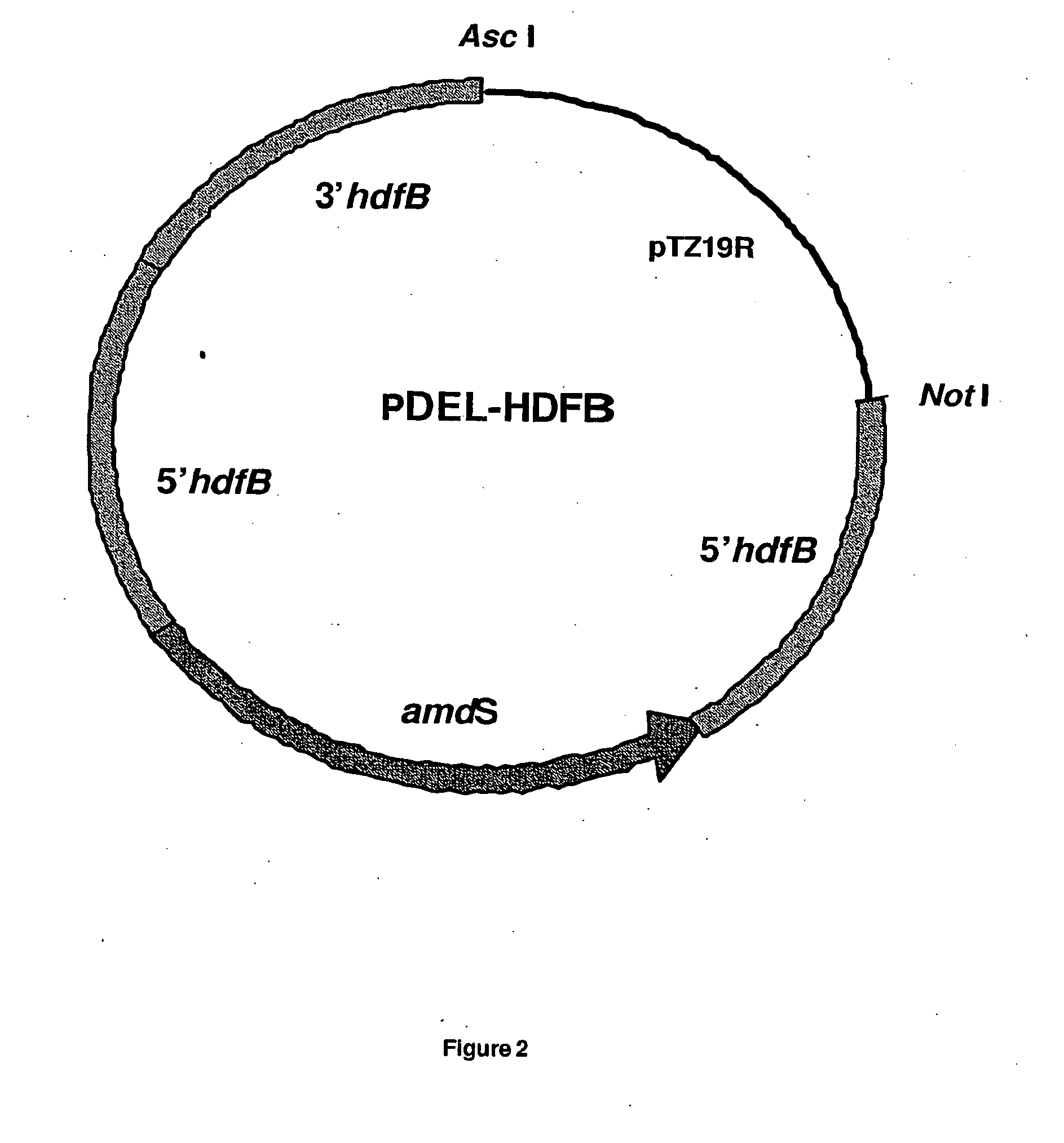Filamentous Fungal Mutants With Improved Homologous Recombination Efficiency
a technology of filamentous fungal and homologous recombination efficiency, which is applied in the field of molecular biology, can solve the problems of unwanted random integration of expression cassettes, region burden, and unwanted modification of host genomes
- Summary
- Abstract
- Description
- Claims
- Application Information
AI Technical Summary
Problems solved by technology
Method used
Image
Examples
example 1
Identification of the hdfA and hdfB Genes and Construction of the Deletion Vectors
[0177]Genomic DNA of Aspergillus niger strain CBS513.88 was sequenced and analyzed. Two genes with translated proteins annotated as homologues to KU70 and KU80, were identified and named hdfA and hdfB respectively. Sequences of the hdfA and hdfB loci, comprising the open reading frame (ORF) (with introns) and approximately 1000 bp 5′ and 3′ of the genes, are shown in sequence listings 1 and 4. Gene replacement vectors for hdfA and hdfB were designed according to known principles and constructed according to routine cloning procedures (see FIGS. 1 and 2). In essence, these vectors comprise approximately 1000 bp flanking regions of the hdf ORFs for homologous recombination at the predestined genomic loci. In addition, they contain the A. nidulans bi-directional amdS selection marker, in-between direct repeats. The general design of these deletion vectors were previously described in EP635574B and WO 98 / 4...
example 2
Inactivation of the hdfA Gene in Aspergillus niger
[0178]Linear DNA of deletion vector pDEL-HDFA (FIG. 1) was isolated and used to transform Aspergillus niger CBS513.88 using method earlier described (Biotechnology of Filamentous fungi: Technology and Products. (1992) Reed Publishing (USA); Chapter 6: Transformation pages 113 to 156). This linear DNA can integrate into the genome at the hdfA locus, thus substituting the hdfA gene by the amdS gene as depicted in FIG. 3. Transformants were selected on acetamide media and colony purified according to standard procedures as described in EP635574B. Spores were plated on fluoro-acetamide media to select strains, which lost the amdS marker. Growing colonies were diagnosed by PCR for integration at the hdfA locus and candidate strains tested by Southern analyses for deletion of the hdfA gene. Deletion of the hdfA gene was detectable by ˜2.2 kb size reduction of DNA fragments covering the entire locus and hybridized to appropriate probes. App...
example 3
Inactivation of the hdfB Gene in Aspergillus niger
[0179]Linear DNA of deletion vector pDEL-HDFB (FIG. 2) was isolated and used to transform the Aspergillus niger strain CBS513.88. This linear DNA can integrate into the genome at the hdfB locus, thus substituting the hdfB gene for amdS (FIG. 4). The same technique of gene replacement was used as the one described in example 2. Transformants were selected on acetamide media and colony purified according to standard procedures. Spores were plated on fluoro-acetamide media to select strains, which lost the amdS marker (EP 635574B). Growing colonies were diagnosed by PCR for integration at the hdfB locus and candidate strains tested by Southern analyses for deletion of the hdfB gene. Deletion of the hdfB gene was detectable by ˜2.6 kb size reduction of DNA fragments covering the entire locus and hybridized to appropriate probes. Approximately 7 strains showed a removal of the genomic hdfB gene from a pool of approximately 370 initial tr...
PUM
| Property | Measurement | Unit |
|---|---|---|
| Fraction | aaaaa | aaaaa |
| Fraction | aaaaa | aaaaa |
| Fraction | aaaaa | aaaaa |
Abstract
Description
Claims
Application Information
 Login to View More
Login to View More - R&D
- Intellectual Property
- Life Sciences
- Materials
- Tech Scout
- Unparalleled Data Quality
- Higher Quality Content
- 60% Fewer Hallucinations
Browse by: Latest US Patents, China's latest patents, Technical Efficacy Thesaurus, Application Domain, Technology Topic, Popular Technical Reports.
© 2025 PatSnap. All rights reserved.Legal|Privacy policy|Modern Slavery Act Transparency Statement|Sitemap|About US| Contact US: help@patsnap.com



